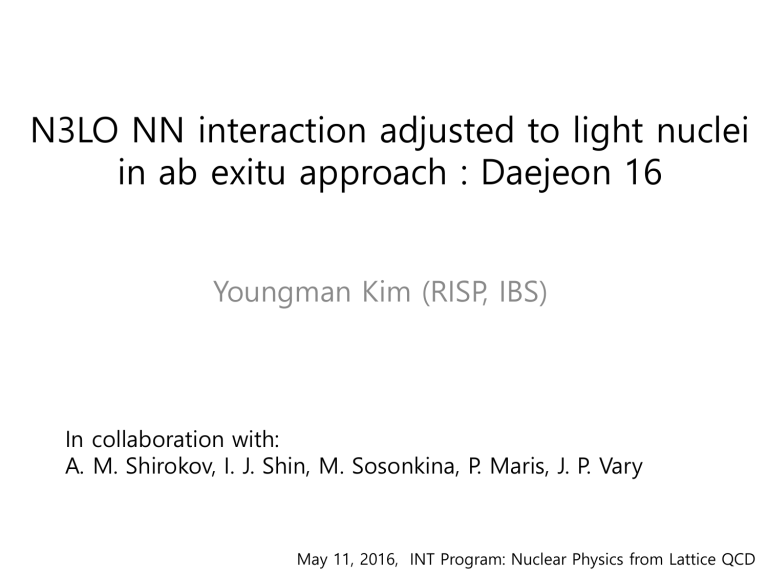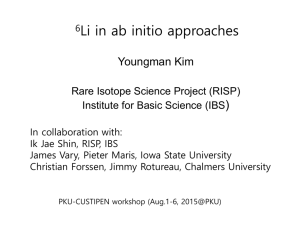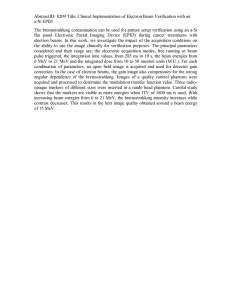N3LO NN interaction adjusted to light nuclei Youngman Kim (RISP, IBS)

N3LO NN interaction adjusted to light nuclei in ab exitu approach : Daejeon 16
Youngman Kim (RISP, IBS)
In collaboration with:
A. M. Shirokov, I. J. Shin, M. Sosonkina, P. Maris, J. P. Vary
May 11, 2016, INT Program: Nuclear Physics from Lattice QCD
• Why Daejeon ?
• Ab initio NCSM in short
• Daejeon 16
• Prospect
* ISOL-type facilities: radioactive ions are produced at rest in a thick target either by direct bombardment with particles from a driver accelerator or via fission induced both by fast and thermal secondary neutrons.
* In-flight (IF) facilities: a high energy ion beam is fragmented in a suitable thin target and the reaction products are and then transported to the secondary target.
RAON Concept
128.5m
20m
ECR-IS (10keV/u, 12 pμA)
LEBT
RFQ (300keV/u, 9.5 pμA)
MEBT
70m
100m SCL1 (18.5 MeV/u, 9.5 pμA)
Driver LINAC
Chg. Stripper
375m
20m
250m
Post Accelerator
100m
Low Energy Experiments
Nuclear Astrophysics
High intensity RI beams by ISOL & IF & KOBRA
ISOL : direct fission of 238 U by 70MeV proton
IF by 200MeV/u, 8.3pμA 238 U
KOBRA by ~ 20 MeV/u, stable ion beams
High quality neutron-rich RI beams
132 Sn with up to ~250MeV/u, up to ~10 8 pps
More exotic RI beams by ISOL + IF
SCL2 (200 MeV/u, 8.3 pμA for U +79 )
SCL3
(600MeV, 660 μA for p)
MEBT
100m
80m
RFQ CB
ECR-IS
HRMS
RF Cooler
High-precision
Mass Measurement
ISOL
Target
IF Target
Cyclotron
(p, 70 MeV, 1mA)
Gas Catcher
μSR,
Bio-medical
IF Separator
110m
CB : Charge Breeder
HRMS : High Resolution Mass Separator
High Energy Experiments
Nuclear Structure/
Symmetry Energy
6
RAON Layout and Beam Parameters
Particle
Injector
Beam energy (MeV/u)
Beam current (pμA)
Power on target (kW)
Driver Linac
High Energy Exp. 2
H + O +8 Xe +54
600 320
High Energy Exp. 1
660 78
> 400 400
251
11
400
U +79
200
8.3
400
Post Acc.
RI beam
18.5
-
-
IF SYSTEM
SCL1(QWR)
ISOL
SYSTEM
SCL3(QWR
/HWR)
Cyclotron
SCL1(HWR)
Cryogenic
System
SCL2(SSR)
Low Energy
Exp.
Charge Stripper
7
Expected RIBs at RAON
IFS:
238
U(200 Mev/u, 400 kW) + C
KOBRA:
40
Ar(30 MeV/u,12 kW) + Be
ISOL: p(70 MeV, 70 kW)+UC x
ISOL+IF:
140
Xe(222 MeV/u, 1E+07 pps)+ C
Z=N
ISOL
KOBRA
<1 pps
Stable line
IF
ISOL+IF
IFS KOBRA ISOL
1.0E+11 1.0E+11 1.0E+11
1.0E+10 1.0E+10 1.0E+10
1.0E+09 1.0E+09 1.0E+09
1.0E+08 1.0E+08 1.0E+08
1.0E+07 1.0E+07 1.0E+07
1.0E+06 1.0E+06 1.0E+06
1.0E+05 1.0E+05 1.0E+05
1.0E+04 1.0E+04 1.0E+04
1.0E+03 1.0E+03 1.0E+03
1.0E+02 1.0E+02 1.0E+02
1.0E+01 1.0E+01 1.0E+01
1.0E+00 1.0E+00 1.0E+00
ISOL+IF
1E+00
1E-01
1E-02
1E-03
1E-04
1E-05
1E-06
1E-07
1E-08
1E-09
1E-10
RAON will provide access to unexplored regions of the nuclear chart
8
RAON Site
~11 km
Current RISP Office
Area (Lot/Bldg): 952,066 m 2 / 130,257 m 2
9
Ab initio No Core Shell Model
• Ab initio: nuclei from first principles considering fundamental interactions without uncontrolled approximations.
• No core: all nucleons are active, no inert core.
• Shell model: harmonic oscillator basis
• Point nucleons
Ab initio structure and NN interaction
• Unfortunately, the NN interaction at low energies needed for nuclear physics applications cannot be directly derived from
QCD at the moment
• Ab initio theory requires, of course, a realistic NN interaction accurately describing NN scattering data and deuteron properties
• Nice to avoid NNN forces? Yes
Ik Jae Shin, Y. Kim, P. Maris, J. P. Vary, C. Forssén, J. Rotureau, N. Michel, arXiv:1605.02819
Ab initio NCFC & ab initio GSM with a natural orbital single-particle basis
Daejeon 16
• We use phase-equivalent transformations to adjust off-shell properties of similarity renormalization group evolved chiral effective field theory NN interaction (Idaho N3LO) to describe binding energies and spectra of light nuclei without NNN forces.
• W. Polyzou and W. Glöckle theorem
[Few-body Syst. 9, 97 (1990))] where V ij and V’ ij
H=T+V ij
H’=T+V’ ij
+V ijk are phase-equivalent, H and H’ are isospectral.
• Is it possible to transform as
H’=T+V’ ij
+V ijk
H=T+V ij with (approximately) isospectral H and H’ to minimize the need for the explicit introduction of three and higher body forces?
"N3LO NN interaction adjusted to light nuclei in ab exitu approach,"
A.M. Shirokov, I.J. Shin, Y. Kim, M. Sosonkina, P. Maris, J.P. Vary. e-Print: arXiv:1605.00413 [nucl-th]
PET (phase equivalent transformation)
• Assume unitary matrix [U] has only a finite matrix mixing of a few selected basis function. Then H and H’ have identical eigenvalues, and also asymptotic behavior of their eigenvector wave functions are same.
do not change scattering phase shifts and bound state energies of twobody system
but are supposed to modify two-body bound state observables such as the rms radius and electromagnetic moments ex) JISP16
[A.M. Shirokov, J.P. Vary, A.I. Mazur and T.A. Weber, Phys. Lett. B 644 (2007) 33]
Phase-equivalent transformations (PETs)
PETs are generated by unitary transformations of the two-nucleon Hamiltonian
December 18, 2015, Seoul
A. Shirokov
JISP16 vs Daejeon16
ISTP
(inverse scattering tridiagonal potential)
N3LO interaction
SRG
(similarity renormalization group)
SRG-evolved N3LO
PET (phase equivalent transformation)
(
JISP16
J -matrix inverse scattering potential)
Daejeon16
PET angles (in degrees) defining the Daejeon16 NN interaction in various NN partial waves.
binding energies of 3 H, 4 He, 6 Li, 8 He, 10 B, 12 C, 16 O
excitation energies of 6 Li [(3 + ,0), (0 + ,1)], 10 B[(1 + ,0)], 12 C[(2 + ,0)]
12 C ground state energy in NCSM calculations obtained with Daejeon16 NN interaction
Extrapolation B
P. Maris, J. P. Vary, and A. M. Shirokov, PRC 79, 014308 (2009)
Binding energies (in MeV) of nuclei obtained with Daejeon16 NN interaction using
Extrapolation B with estimated uncertainty of the extrapolation.
Excitation energies (in MeV) of some nuclei obtained with Daejeon16 NN interaction.
Our calculations with Daejeon16 demonstrate that the 10 B ground state spin can be obtained using only two-nucleon interaction which, however, mimics the effects of NNN forces by modification of its off-shell properties by means of PETs.
12 C point-proton radius obtained with Daejeon16 (solid lines) and
JISP16 (dashed lines) NN interactions in NCSM calculations.
We use these crossing points as rough estimates of the converged radius as has been suggested in M. A. Caprio, P. Maris, J. P. Vary, PRC 90, 034305 (2014)
Binding energies
Binding energies (expanded scale)
“Intense” RI beams
Infrared slavery beyond the Standard Model
Properties of neutron stars
Stellar explosions
Energy generation in stars
Supercomputers
Asymptotic freedom vacuum
Chemical history of the universe
Limits of nuclear existence
Simplicity from complex systems
Origin of elements
Origin of nucleon mass
Quantum tunneling
Phases of nuclear matter
Strong interactions at work
Hadrons
Quarks and gluons http://www.physics.adelaide.edu.au/theory/staff/leinweber/VisualQCD
/QCDvacuum/




